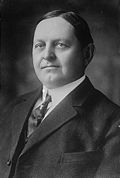| |||||||||||||||||
| |||||||||||||||||
 County results Underwood: 40–50% 50–60% 60–70% 70–80% 80–90% >90% Birch: 40–50% 60–70% Longshore: 50–60% | |||||||||||||||||
| |||||||||||||||||
| Elections in Alabama |
|---|
 |
The 1914 United States Senate election in Alabama was held on November 3, 1914. Incumbent U.S. Senator Frank White, who had been elected in a May 11, 1914, special election to fill the remaining months of Senator Joseph F. Johnston's term, did not run for re-election. U.S. Representative Oscar Underwood, the House Majority Leader, won the Democratic primary over fellow Representative Richmond P. Hobson. In the general election, he defeated Republican nominee Alex C. Birch in a landslide.

